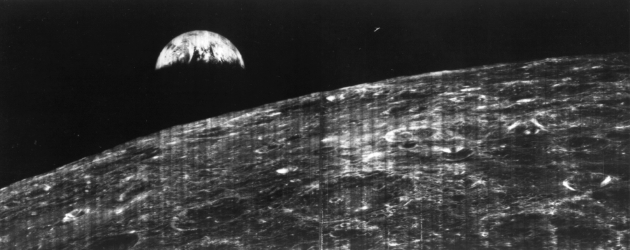 First View of Earth from Moon/ NASA
First View of Earth from Moon/ NASA This is a Guest Blog Post to the IEEE SSIT Technology and Society FutureProof Blog by Joe Carvalko.
________________
I saw the dark side of the Moon in the company of a few, who like me, were to bear witness to something for the first time in human history.
On August 10, 1966, a daylight meteor was seen in the sky from Utah to Canada. It’s said to be the only known case of a meteor entering the Earth’s atmosphere and leaving it again. It was also on that day, at 2:26 p.m., Eastern time, from Cape Kennedy, Lunar Orbiter 1, the first spacecraft to orbit the Moon, was launched. Four days later, at 8:43 a.m., Eastern time, the spaceship successfully entered an orbit around the Moon, becoming the first human-made object to orbit a heavenly body other than Earth. And, for the first ever time, closed circuit T.V. video streamed, black and white photographs of the Moon’s surface back to our planet. I’d been working for the company that developed the Bolsey scanner, a gizmo that mounted on a camera to calculate the angular rate of travel or panning rate, the camera was moving relative to the surface of the Moon. The result was to effectively move the camera lens, to reduce the blurring that normally occurs when photos are taken from a moving vehicle.
In 1966, as launch deadlines approached and the lab buzzed in frenzied electricity, far different from the heady, somber, research lab we read about in history books. They called us Aerospace engineers, techno-itinerants going from one government contract to another. A young, bunch, short on maturity, who fiddled with transistors and optics all day. And, more than a few times a week, had supper at the local hangout, downed a few beers, and returned to our workbenches to jump the next hurdle, which might make landing on the Moon possible.
We worked for Emil Bolsey, the genius behind the technology, who spoke his mind in equations scribbled between the semi-hard covers of an engineer’s notebook. Day after day we’d translate his algebraic hieroglyphics into electronic symbols, and then bread-boarded a transistor here, a capacitor there (chips, microprocessors didn’t exist, yet). We analyzed, tested it, made changes, and when we thought we’d figured everything out, accounted for every detail, every variable, more times than not something wasn’t perfect. But, on launch day it was.
From 250,000 miles away, the spaceship began to assemble bursts of data that had made its way across a vacuum of space. NASA would use the photos to plot the landing sites for the Apollo missions to follow. That first mission photographed 42 high-resolution and 187 medium-resolution pictures, covering over 5 million square kilometers of the Moon’s surface. During the next two-years five Lunar Orbiters circled the Moon in succession, with Bolsey scanners helping relay photos back to Jet Propulsion Laboratories in Pasadena, California.
And 50 years ago, in another science lab, with other colleagues, each coming from different companies, each in some way contributing to the Moon shot, I listened to a radio broadcast: “Apollo 11, its crew atop a Saturn V rocket, launched from Kennedy Space Center, today, July 16, 1969 at 9:32 a.m. Eastern time.” I felt a measure of pride, knowing that in a few days, we’d would put earthmen at a precise spot on the Moon, selected from the photos snapped in a time when we were driven by President Kennedy’s call for America to do something, not because it was easy, but because it was hard.
About the Author

Learn more about Joe Carvalko HERE.
Posted with permission from the author.






 JOIN SSIT
JOIN SSIT